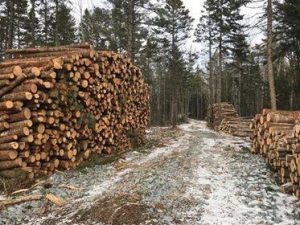 So reads an introduction by Woods and Waters Nova Scotia (public Facebook group) to a message and photos forwarded from a worker for a woodlot in Upper Rawdon, N.S.
So reads an introduction by Woods and Waters Nova Scotia (public Facebook group) to a message and photos forwarded from a worker for a woodlot in Upper Rawdon, N.S.
“I work for a woodlot owner co-op that manages this lot in Upper Rawdon. One of the pictures shows hemlock biomass and the end result of the harvest. I don’t mind this wood going as biomass. It certainly won’t be going to the disaster in C.B. though. Taylor lumber has a small biomass plant at their mill and that is where this wood will be going. I’m not sure of the efficiency of their plant but I know it is a lot better than the one in C.B. and they aren’t clear cutting hardwoods to feed it. We also got some fine sawlogs off the lot and more importantly it made room for the best of the trees to keep growing.
“The total size of the harvest was 5.26 hectares (13 acres) which generated a total of 300 tonnes of wood products. I should say that we also did a small (under 5 acre) clearcut on the property in a stand of dying fir…
Read more on Woods and Waters Nova Scotia
Also view We can “cut less and do more” to foster a healthy forest economy in Nova Scotia
Post Apr 20, 2017 about Taylor Lumber enterprises operating out of Middle Musquodoboit, and opinions Robert Taylor expressed in a presentation to the Nova Scotia Legislature Resources Committee on April 20, 2017. Some extracts from the post:
Taylor was talking from his 42 years of experience and that of prior generations in his family business. He says they cut less than they used to, but do more with it which creates more jobs. Waste from one process goes into another, all locally processed. The greenhouse will use waste steam, saving the 60% of costs that most greenhouses spend on energy. (I wonder also, if they might cycle some of CO2 from the co-generation plant through the greenhouse, as many plants respond to increased levels of CO2). So, he said, they will produce one head of lettuce as a by-product from harvesting one fir tree.
Taylor says as a province we need to push buying local, noting that Superstore and Sobey’s promote local farm produce, and we should do the same with wood. He’s not hot on government subsidies to industry (“pulp and paper bailouts result in poor business models”), but he says government could do much more to promote buying local and at the same time encourage sustainable forestry, e.g. by offering rebates to consumers building houses with lumber produced locally with wood coming from FSc-certified woodlots.
Nova Scotia is not a big player in the lumber trade, and while trade has its place in the Nova Scotian forest economy, the focus, says Taylor, should be local. He said local consumption of wood has the potential to use every piece of lumber produced by our mills.
